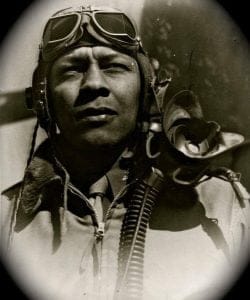 William Ayers Campbell
William Ayers Campbell
April 12, 1917 – April 24, 2012
Class 42-F-SE 7/3/1942 2nd Lt. 0790453 Tuskegee AL
William A. Campbell was born in Tuskegee, Alabama on April 12, 1917, the fourth child of Thomas Monroe Campbell, the first Cooperative Extension Agent in the United States, and Anna Campbell. In total, he had five siblings, including three younger than himself.
Campbell attended elementary and high school in Tuskegee, Alabama. He then matriculated at the Tuskegee Normal and Industrial Institute from which he graduated with his Bachelor of Science degree in Business in 1937.
Following his graduation from the Tuskegee Normal and Industrial Institute, Campbell went to work as a clerk for the U.S. Dept. of Agricultural Extension. During his time working for Agricultural Extension, he encountered an opportunity to enroll in the Tuskegee Army Air Field class SE-42-F. He graduated from the program on July 3, 1942 as a second lieutenant. Campbell was then assigned to the 99th Pursuit Squadron of the 332nd Fighter Group, which was stationed in Farjouna, Tunisia in 1943. Due to the distinctive red paint on the tails of their planes, the 99th Pursuit Squadron came to be known as the “Redtails.
Campbell flew in the first combat mission of the 99th Pursuit Squadron on June 2, 1943, as they served as wingmen to pilots of the 332nd Fighter Group during World War II.
Campbell, Spann Watson, and Herbert V. Clark were given orders to return to the United States to train replacement pilots. They left the European theater on November 5, 1943 and reported for duty to the 553d Fighter-Bomber Squadron in Michigan in December 1943.
Campbell returned to the Europe in 1944 as a Captain and, on October 11, 1944, joined the 332d Fighter Group as it made a strafing run-on targets on the railroads and on the Danube River from Budapest to Bratislava. The mission successfully destroyed 17 enemy airplanes on the ground. Eighteen days later, he assumed command of the 99th Fighter Group as a full Major, replacing Captain Alfonza W. Davis, on October 29, 1944.
Campbell received the Distinguished Flying Cross on New Year’s Day 1945; the medal was presented to him by Brigadier General Dean C. Strother.
Three months later, on March 31, 1945, Campbell participated in a mission of the 332d Fighter Group to destroy railroad and other targets in the area surrounding Munich, Germany. The mission successfully shot down 13 enemy fighters; Campbell was credited for one of the 13 kills.
On April 15, 1945, Campbell participated in another strafing mission of railroad targets in the areas around Munich, Salzburg, Linz, Pilzen, and Regensburg. For his actions, Campbell earned his second Distinguished Flying Cross. He became the first African American pilot to receive the Distinguished Flying Cross when he was officially awarded the oak leaf cluster to his cross on May 29, 1945.
Over the course of World War II, Campbell actively served in the Sicilian and Italian campaigns and flew 106 missions, becoming the first African-American pilot to drop a bomb on enemy targets in United States history.
Following World War II, Maj. Campbell assumed the position of Group Commander of the 332nd Fighter Group on August 28, 1947. Campbell went on to fight in two more wars during his military career, as he served in both Korea and Vietnam. He remained in the service until 1970, reaching the rank of full colonel.
After his retirement from active duty in 1970, Campbell taught Defense Resource Management at the Naval Postgraduate School in Monterey, California for 13 years and was a member of the Tuskegee Airmen Commission established by the State of Alabama.
Colonel Campbell also had a wonderful family life. After a short courtship following WWII, he married Wilma Jean Burton from Chicago in September of 1946. Together they raised three sons, traveled the world and enjoyed friendships built over a lifetime. While attending a past Tuskegee Airmen Convention, he was asked what advice he would give to a young person trying to achieve their dream. Bill said, “Do the best you are capable of doing, that’s all you can do; but do it all the time.”
Bill was an extremely gifted athlete; his first love was tennis. He won an untold number of single and doubles tournaments while serving in the U.S. Air Force. As a member of the Monterey Peninsula community, Bill served as a volunteer with a number of community based organizations which included: The Meadowbrook Tennis Club, The Monterey Peninsula Branch of the NAACP and the Legal Aid for Senior Citizens.
Visit our Virtual Museum to see the 1944 portrait of William A. “Bill” Campbell
Sources:





